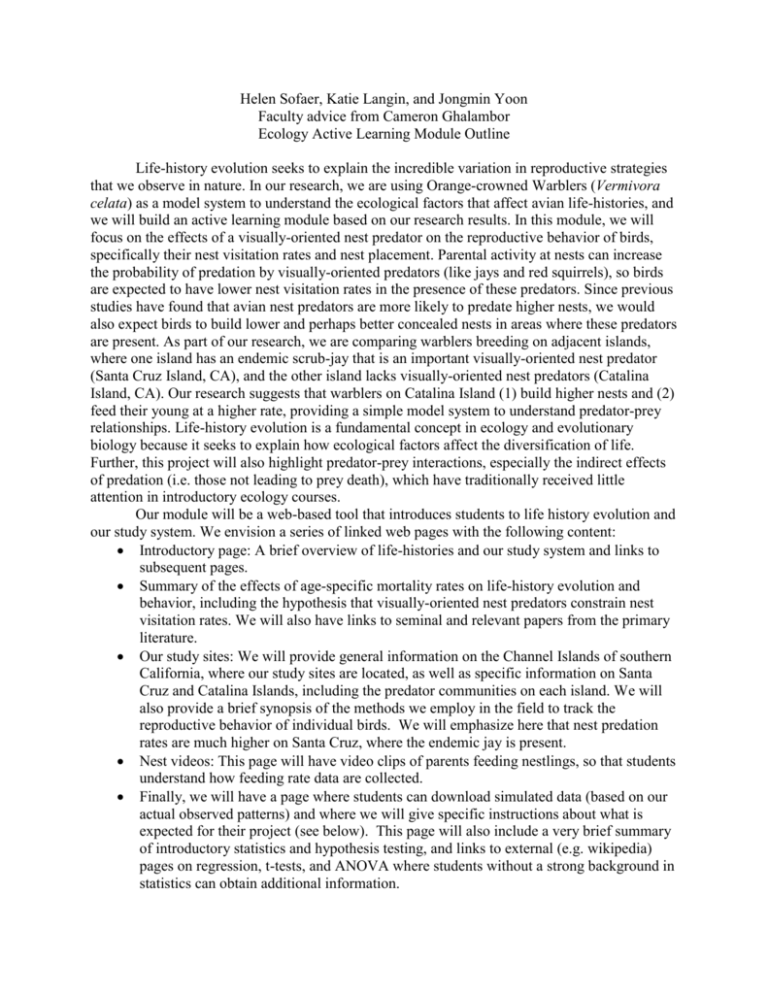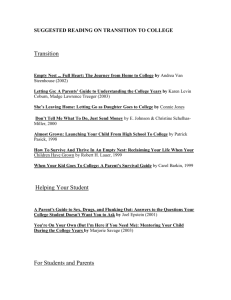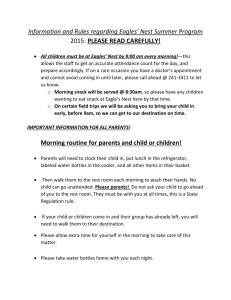Ecology Active Learning Modules
advertisement

Helen Sofaer, Katie Langin, and Jongmin Yoon Faculty advice from Cameron Ghalambor Ecology Active Learning Module Outline Life-history evolution seeks to explain the incredible variation in reproductive strategies that we observe in nature. In our research, we are using Orange-crowned Warblers (Vermivora celata) as a model system to understand the ecological factors that affect avian life-histories, and we will build an active learning module based on our research results. In this module, we will focus on the effects of a visually-oriented nest predator on the reproductive behavior of birds, specifically their nest visitation rates and nest placement. Parental activity at nests can increase the probability of predation by visually-oriented predators (like jays and red squirrels), so birds are expected to have lower nest visitation rates in the presence of these predators. Since previous studies have found that avian nest predators are more likely to predate higher nests, we would also expect birds to build lower and perhaps better concealed nests in areas where these predators are present. As part of our research, we are comparing warblers breeding on adjacent islands, where one island has an endemic scrub-jay that is an important visually-oriented nest predator (Santa Cruz Island, CA), and the other island lacks visually-oriented nest predators (Catalina Island, CA). Our research suggests that warblers on Catalina Island (1) build higher nests and (2) feed their young at a higher rate, providing a simple model system to understand predator-prey relationships. Life-history evolution is a fundamental concept in ecology and evolutionary biology because it seeks to explain how ecological factors affect the diversification of life. Further, this project will also highlight predator-prey interactions, especially the indirect effects of predation (i.e. those not leading to prey death), which have traditionally received little attention in introductory ecology courses. Our module will be a web-based tool that introduces students to life history evolution and our study system. We envision a series of linked web pages with the following content: Introductory page: A brief overview of life-histories and our study system and links to subsequent pages. Summary of the effects of age-specific mortality rates on life-history evolution and behavior, including the hypothesis that visually-oriented nest predators constrain nest visitation rates. We will also have links to seminal and relevant papers from the primary literature. Our study sites: We will provide general information on the Channel Islands of southern California, where our study sites are located, as well as specific information on Santa Cruz and Catalina Islands, including the predator communities on each island. We will also provide a brief synopsis of the methods we employ in the field to track the reproductive behavior of individual birds. We will emphasize here that nest predation rates are much higher on Santa Cruz, where the endemic jay is present. Nest videos: This page will have video clips of parents feeding nestlings, so that students understand how feeding rate data are collected. Finally, we will have a page where students can download simulated data (based on our actual observed patterns) and where we will give specific instructions about what is expected for their project (see below). This page will also include a very brief summary of introductory statistics and hypothesis testing, and links to external (e.g. wikipedia) pages on regression, t-tests, and ANOVA where students without a strong background in statistics can obtain additional information. The students will be instructed to read the background material provided on our site, and then download and analyze the data. We will include the following variables in our dataset: island, year, territory ID, female age, male age, nest height, nest concealment, feeding rate, and number of nestlings. Given these data, the students will be expected to address one question regarding the reproductive behavior of Orange-crowned Warblers. For instance, they may choose to ask: (1) Do parents feed at a higher rate on the island without the visually-oriented nest predator?, (2) Do females build more conspicuous nests on Catalina (using nest height or nest concealment as the variable of interest)?, or (3) Do parents feed at a lower rate when their nests are higher or poorly concealed? We will not spell these questions out to them; rather, they will be expected to develop an interesting question based on the background material and the data available. We will ask them to address only one question to keep the reports short for grading purposes. We will simulate the data so that (1) feeding rates are higher on Catalina, (2) nest height is higher on Catalina, and (3) feeding rates are negatively correlated with nest height on Santa Cruz (with a predator) but are not related to nest height on Catalina (without a predator). We may also include other additive effects on feeding rates (e.g. parental age, nestling number, nest concealment) and/or include these variables without having them affect feeding rates. (We’d also like some feedback on if students can be expected to be able to analyze and interpret a statistical interaction.) We will provide an analysis of each of the potential effects to Joe and Indy, to serve as a key for grading student assignments. Students will be expected to turn in a short report that includes their data analysis and interpretation and answers to specific questions. We envision requiring a short introduction (<200 words) explaining their research hypothesis, why predators should affect reproductive behavior, and what prediction(s) they made. We will ask students to provide short methods section (<100 words), followed by their results which should include the relevant statistics and at least one figure. Students will provide a brief conclusion (<100 words) that provides an interpretation of their results and discusses how well the data conformed to their prediction(s). We may also ask several short answer (<50 words) questions of a broader nature, such as: 1) Some studies have shown that nest predators may increase in abundance in urban, suburban, and fragmented environments. How should nest provisioning rates vary along a rural-urban gradient? 2) If clutch size differed between these two islands, on which island would you expect smaller clutches? 3) If we studied two different populations that had and lacked an adult predator, how would this change our results? Which population might have a larger clutch size? 4) Can we say that the presence of the nest predator caused feeding rates to be lower? If so, why? If not, what would we need to do to establish this effect? Our goal for this exercise is to introduce students to ideas in life-history evolution, predator-prey interactions, and behavioral ecology while giving them an opportunity to ask an interesting question, analyze an ecological dataset, and interpret the significance of their results in a broader context. By giving the students flexibility to develop their own research question, we hope to provide them with an opportunity to think about and be creative with their analyses.








